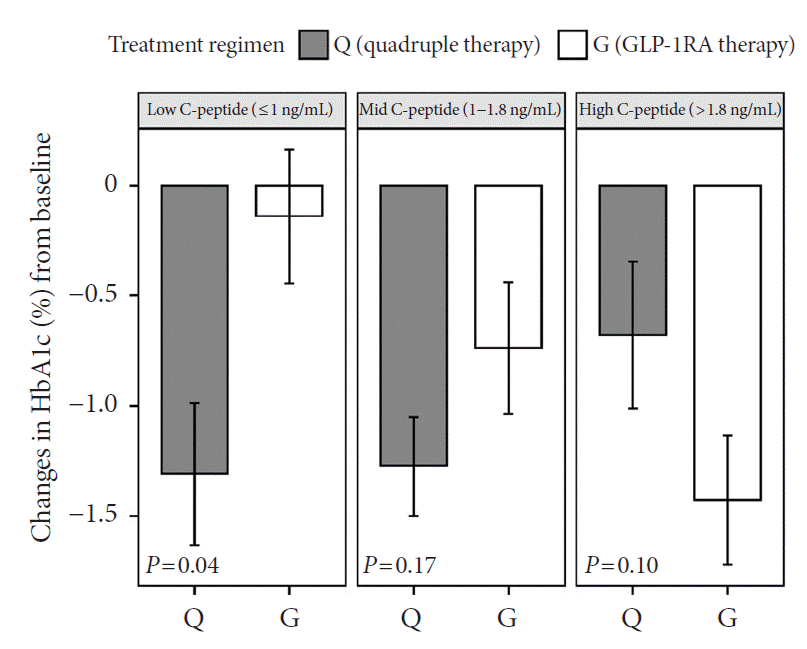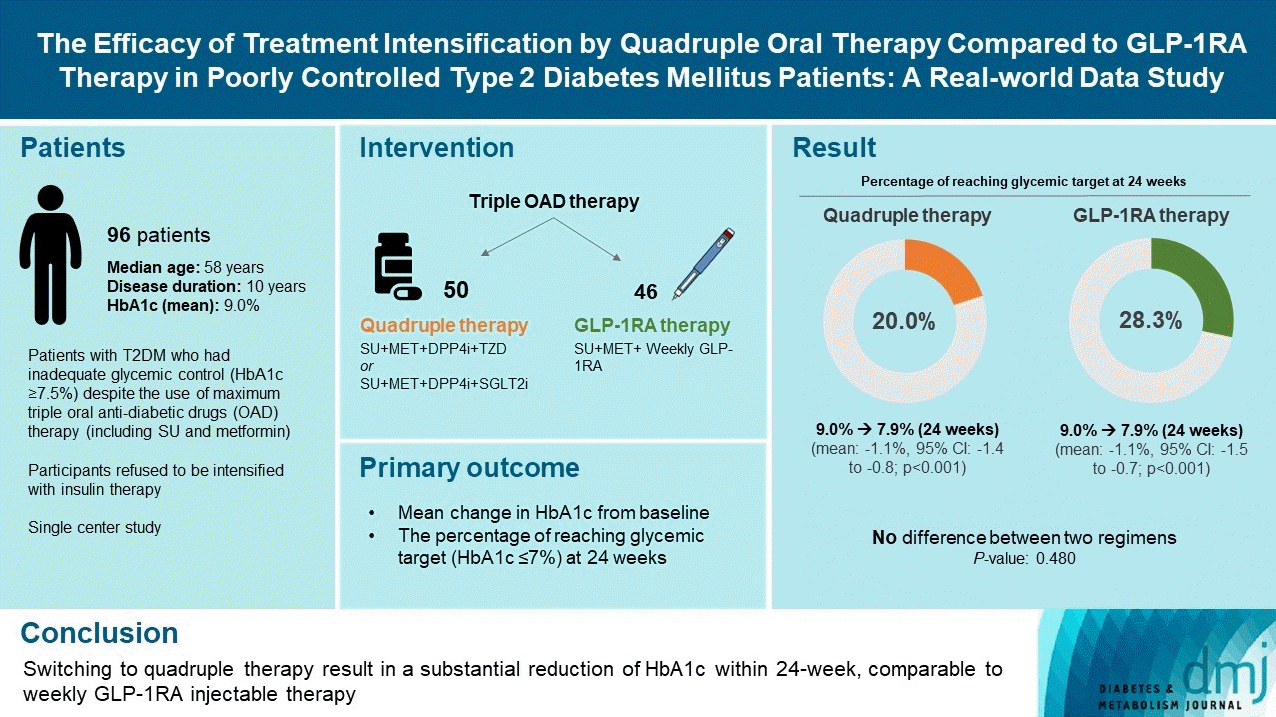This article has been
cited by other articles in ScienceCentral.
Abstract
We compared the glycemic efficacy of treatment intensification between quadruple oral antidiabetic drug therapy and once-weekly glucagon-like peptide-1 receptor agonist (GLP-1RA)-based triple therapy in patients with poorly controlled type 2 diabetes mellitus refractory to triple oral therapy. For 24 weeks, changes in glycosylated hemoglobin (HbA1c) from baseline were compared between the two treatment groups. Of all 96 patients, 50 patients were treated with quadruple therapy, and 46 were treated with GLP-1RA therapy. Reductions in HbA1c for 24 weeks were comparable (in both, 1.1% reduction from baseline; P=0.59). Meanwhile, lower C-peptide level was associated with a lower glucose-lowering response of GLP-1RA therapy (R=0.3, P=0.04) but not with quadruple therapy (R=–0.13, P=0.40). HbA1c reduction by GLP-1RA therapy was inferior to that by quadruple therapy in the low C-peptide subgroup (mean, –0.1% vs. –1.3%; P=0.04). Treatment intensification by switching to quadruple oral therapy showed similar glucose-lowering efficacy to weekly GLP-1RA-based triple therapy. Meanwhile, the therapeutic response was affected by C-peptide levels in the GLP-1RA therapy group but not in the quadruple therapy group.
Keywords: Dapagliflozin, Diabetes mellitus, type 2, Dulaglutide, Drug combinations, Empagliflozin, Thiazolidinediones, Treatment outcome
INTRODUCTION
Type 2 diabetes mellitus (T2DM) is a progressive disease accompanied by a decline in β-cell function and worsening of insulin resistance [
1]. As a result, earlier and intensive treatment is vital to enable additional patients to reach glycemic targets [
2]. Glucagon-like peptide-1 receptor agonist (GLP1RA) therapy was preferred for patients requiring potent injectable therapies [
3]. However, therapeutic inertia contributes to the burden of optimal glycemic control, and injection therapy is not preferred especially due to non-adherence and anxiety about injection [
4].
Quadruple therapy is a valid option for treating T2DM, especially when injectable therapy with insulin is not widely accepted due to various factors [
5]. Ku et al. [
6] demonstrated that adding a fourth oral antidiabetic drug (OAD) to conventional triple OAD therapy compared to switching to basal insulin induced a higher glucose-lowering effect without increasing hypoglycemic risk. However, in Korea, quadruple oral combination therapy is not covered by national health insurance. We sought to compare the efficacy and safety between quadruple therapy and weekly GLP-1RA-based triple therapy in poorly controlled T2DM patients. Additionally, we identified factors associated with the glucose-lowering effect of intensification by changing to either quadruple or GLP-1RA therapy during 24 weeks.
METHODS
Study design and population
From March 2016 to December 2020, we recruited patients who had inadequate glycemic control (glycosylated hemoglobin [HbA1c] ≥7.5%) despite the use of triple OAD therapy (including sulfonylurea [SU] and metformin [MET]) for more than 6 months. Insulin-based treatment was recommended to all patients, but they refused. Alternatively, two treatment intensification strategies were adopted to achieve the glycemic target, including quadruple oral therapy or once-weekly GLP1-RA (dulaglutide)-based triple therapy. In the quadruple group, sodium-glucose cotransporter 2 inhibitors (SGLT2i) or a thiazolidinedione (TZD) were added as the fourth OAD following combination with SU, MET, and dipeptidyl peptidase-4 inhibitors (DPP-4i). In the GLP-1RA therapy group, SU and MET were maintained, and third OAD were switched to weekly GLP-1RA. Dulaglutide was initially prescribed with 0.75mg/week and switched to 1.5 mg/week at 12-week. Patients with concomitant disease or conditions that caused secondary hyperglycemia were excluded. Patients with advanced kidney disease (stage ≥4) or low C-peptide level at baseline (<0.6 ng/mL) were also excluded.
The index date was defined as when the patients were first prescribed quadruple therapy or GLP-1RA therapy during the enrollment period. Baseline laboratory findings were defined as the latest plasma glucose, HbA1c, C-peptide, renal function, and lipid profile performed within three months of the index date. Additionally, the subjects were divided into three groups according to the baseline C-peptide values: low level (≤1.0 ng/mL, n=14), middle level (1.1 to 1.8 ng/mL, n=34), and high level (>1.8 ng/mL, n=40) groups. The primary and secondary outcomes were assessed at 24 weeks from the index date. Written informed consent by the patients was waived due to a retrospective nature of our study. This study was approved by the ethics committee of Gyeongsang National University Changwon Hospital (IRB no. GNUCH 2021-07-038).
Outcomes
The primary outcome was mean change in HbA1c level from baseline and the percentage of reaching HbA1c level (≤7.0%) at 24-week. Factors associated with the therapeutic efficacy of each treatment were assessed. Secondary outcomes included any adverse events that occurred during the study period.
Statistical analysis
Continuous variables are presented as mean±standard deviation or median (interquartile ranges). Categorical variables were compared using the chi-square test or linear-by-linear association test. A paired t-test or Wilcoxon signed-rank test was performed to compare the changes in HbA1c for 24 weeks. Pearson correlation coefficient was performed to evaluate the linear correlation between two continuous variables. Multivariate logistic regression analysis was performed to identify independent factors associated with reaching the glycemic target (HbA1c ≤7.0%) at 24-week. The model was adjusted for age, sex, body mass index (BMI), disease duration, baseline HbA1c, treatment regimen (quadruple therapy vs. GLP-1RA therapy), and baseline C-peptide. Statistical analyses were performed using SPSS version 24.0 (IBM Co., Armonk, NY, USA), and figures were drawn in R version 3.2.5 (R Foundation for Statistical Computing, Vienna, Austria). All statistical tests were two-tailed, and the significance level was set at P<0.05.
RESULTS
During the study period, 148 patients were initially switched to quadruple or GLP-1RA therapy, and finally, 96 patients were included in the study (
Supplementary Fig. 1). The median age and disease duration was 58 and 10 years, respectively (
Table 1). Mean HbA1c at baseline was 9.0%, and median C-peptide level was 1.7 ng/mL. The most common composite of triple OAD at baseline was SU+MET+DPP-4i (
n=64, 66.7%), followed by SU+MET+SGLT2i (
n=28, 29.2%) and SU+MET+TZD (
n=4, 4.2%). In the quadruple group, 13 patients (26%) used SU+MET+DPP-4i+SGLT2i combination therapy, and 37 patients (74%) used SU+MET+DPP-4i+TZD combination therapy.
HbA1c levels decreased significantly at 24 weeks in both groups; from 9.0% to 7.9% (mean, –1.1%; 95% confidence interval [CI], –1.4 to –0.8;
P<0.001) in the quadruple group; and from 9.0% to 7.9% (mean, –1.1%; 95% CI, –1.5 to –0.7;
P<0.001) in the GLP-1RA group (
Supplementary Fig. 2A). The proportion of patients who reached the glycemic goal (HbA1c ≤7.0%) at 24-week was also comparable between groups (20% in the quadruple group vs. 28.3% in the GLP-1RA group,
P=0.48) (
Supplementary Fig. 2B).
Overall, patients who reached the glycemic target (HbA1c ≤7.0%) at 24 weeks (
n=23, 24.0%) were younger (mean 51 years old vs. 59 years old,
P=0.01), had higher BMI (median 27.6 kg/m
2 vs. 25.4 kg/m
2,
P=0.02) than those who did not reach (
n=73) (
Supplementary Table 1). In multivariate logistic regression analysis, higher C-peptide level at baseline was independently associated with reaching the glycemic target (HbA1c ≤7.0%) at 24 weeks (odds ratio, 1.18; 95% CI, 1.01 to 1.37;
P=0.04) (
Supplementary Table 2) in the GLP-1RA group. Changes in HbA1c levels during 24-week was positively associated with baseline C-peptide levels in the GLP-1RA group (
R=0.3,
P=0.04) but not in the quadruple group (
R=–0.13,
P=0.40) (
Supplementary Fig. 3). In the low C-peptide subgroup (≤1 ng/mL), the glucose-lowering effect of GLP-1RA therapy was weaker than quadruple therapy (–0.1% vs. –1.3%,
P=0.04) (
Fig. 1).
No specific adverse events were identified in quadruple and GLP-1RA therapy groups (
Supplementary Table 3). A total of five patients (5.2%) experienced mild hypoglycemia (level 1), and one patient in the quadruple group complained of weight loss after SGLT2i was added. Six patients (13%) in the GLP1RA group experienced mild gastrointestinal discomfort without discontinuation.
DISCUSSION
Switching to quadruple therapy resulted in a substantial reduction of HbA1c (mean 1.1%) within 24-week, comparable to GLP-1RA therapy. Lower C-peptide level affects the therapeutic efficacy of GLP-1RA therapy but not in quadruple therapy. There were no significant adverse effects during the study period.
This study is the first to address the comparative effectiveness of quadruple therapy and GLP-1RA-based triple therapy in poorly controlled T2DM patients. The glucose-lowering efficacy of quadruple oral combination therapy was previously demonstrated in a 12-month follow-up retrospective observational study [
7]. Comparing the efficacy of treatment intensification with insulin glargine, switching to quadruple therapy that consists of dapagliflozin with three other OADs had a similar glucose-lowering effect as insulin glargine therapy [
8]. Meanwhile, a meta-analysis study reported that the glycemic efficacy of adding injectable GLP-1RA was similar or greater than that of adding basal insulin [
9]. Quadruple therapy could be an alternative intensification treatment option as effective as a GLP-1RA therapy for those who require more potent treatment but were unable or refuse to switch to insulin therapy.
Although the overall therapeutic efficacy of both treatment intensification strategies was comparable, the marker of β-cell function, represented by the C-peptide level, affects the glycemic response to GLP-1RA therapy but not the quadruple therapy. A previous study showed that low β-cell function was associated with reduced glycemic response to GLP-1RA therapy [
10], and a lower urinary C-peptide creatinine ratio was associated with reduced glycemic response to liraglutide in an observational study [
11]. Consistent with these findings, our findings also reflect that the therapeutic efficacy of GLP-1RA may be attenuated in patients with impaired β-cell function. As a result, it would be necessary to consider the residual β-cell function when choosing treatment intensification strategies as the β-cell function decline over decades with a duration of diabetes [
12].
Our study has several limitations. First, due to a retrospective observational study design, the glucose-lowering efficacy of each treatment cannot be generalized in clinical practice. In addition, it was hard to comprehensively evaluate the long-term effects or adverse events due to the short follow-up duration of each treatment. Second, patients who initiated but did not complete 24 weeks of treatment were excluded from the study, and factors affecting the maintenance of treatment could not be identified. Third, this study did not evaluate the additional pleiotropic effect of SGLT2i or GLP-1RA on weight and blood pressure. Fourth, because patients who may not benefit from quadruple or GLP-1RA therapy were excluded at baseline, selection bias might affect the results of glycemic response in each treatment. Additionally, more obese patients were included in the GLP-1RA group because prescribing GLP-1RA was covered by national insurance with a BMI of 25 kg/m2 or higher.
In conclusion, we demonstrated that quadruple oral therapy as an intensification strategy is an attractive treatment option as once-weekly GLP-1RA-based therapy in patients with T2DM who did not reach the glycemic target but refused or were reluctant to switch to injectable therapy. Meanwhile, the residual β-cell function should be considered when planning a treatment intensification strategy.





 PDF
PDF Citation
Citation Print
Print




 XML Download
XML Download